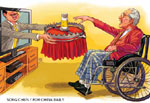Diabetes rate soars in Chinese-Canadians: study
Updated: 2013-05-31 11:18
(English.news.cn)
|
|||||||||||
Chinese-Canadians may be at a higher risk of being diagnosed with diabetes even with their lower rates of obesity, according to a new study released Thursday.
Researchers from the Institute for Clinical Evaluative Sciences (ICES) in the Canadian city of Toronto found that the incidence of diabetes increased 15-fold between 1996 and 2005 among Canadians of Chinese origin, while it only went up 24 percent in European-Canadians.
Published in the American journal Diabetes Care on Thursday, the study was conducted to explore a change they were noticing in the Chinese-Canadian population, the study's co-author Dr. Baiju Shah said in a phone interview. The findings were surprising, he said, mainly because they weren't traditionally seen to be particularly vulnerable to the disease.
"Historically, most of the data in Canada and elsewhere suggested that Chinese-Canadians don't have a particularly increased rate of diabetes," he said.
Shah and his team analyzed the health surveys carried out by Statistics Canada between 1996-2005, and also used information gathered from people who identified themselves as either being of Chinese or European origin, those who were living in Ontario and didn't have diabetes at the time. The team tracked those 77,000 people over a five-year period.
The results revealed only a slight bump in cases of diabetes in European-Canadians over time. But the same couldn't be said for Chinese-Canadians. "It grew really rapidly," Shah said about the Chinese population.
The incidence of diabetes in Chinese-Canadians grew from 1.3 cases per 1,000 people to 19.6 over a nine-year period.
Some of that could be attributed to the increasingly unhealthy lifestyle Chinese-Canadians have taken up, Shah suspected. For one, the large migration of Chinese-Canadians into the suburbs have resulted in a more sedentary lifestyle.
"When the main Chinatown was downtown, that's a very urban area you can walk... you walked to the stores, walked to the parks, everything is close by," said Shah. "Now that much of the Chinese community has moved to the suburbs, they're much more car- dependent communities where you have to go into the car just to go get a pint of milk."
Related Stories
46 children discharged after suspected food poisoning in SW China 2013-05-30 10:04
Singapore recalls food products from Taiwan on unapproved additive 2013-05-28 09:35
Australia vows to cater to China's rising food demand 2013-05-27 15:28
8th China Catering & Food Fair kicks off in Beijing 2013-05-17 13:30
Health food fraud targeted 2013-05-17 10:21
Today's Top News
China corrects Japan on treaty's Diaoyu implications
Manila condemned over grounded warship
Russian envoy vows to boost ties
EU to step up investment in China
Higher education goes global
Plastic ban fails with ultra-thin bags
Flow test for water project gets underway
Campaign to help moms find breastfeeding rooms
Hot Topics
Lunar probe , China growth forecasts, Emission rules get tougher, China seen through 'colored lens', International board,
Editor's Picks

|

|

|

|

|

|







